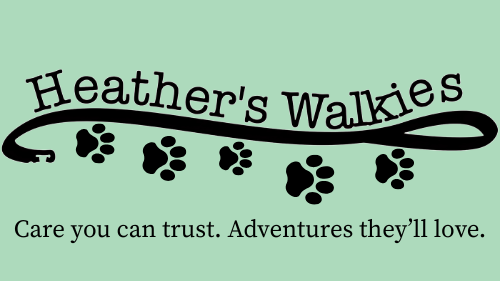Frequently Asked Questions
Where do you walk, and how far do you go?
My walks so much more than a quick dash out and home again. Dogs are encouraged to sniff, investigate objects and smells. I often do enrichment activities, such as searching for treats in the grass, or the “cookie tree” game. We also enjoy playing games such as “catch” and “name recognition” to encourage recall skills and having fun. We usually only cover around 1.5-2miles in the hour, as we are busy enjoying ourselves rather than marching quickly! We walk in open countryside and in woodlands, so your dog will get muddy, though I wash paws after each walk to minimise how much mud they bring home.
How many dogs do you walk at a time?
I walk a maximum of 4 dogs. This is the number recommended by the RSPCA and many dog walking professional bodies. This is partly for safety, partly to ensure that each dog can get enough attention from me, and partly because I use public paths and it is not fair on other dogs to encounter large packs.
How do you transport the dogs?
Dogs are transported in secure crates inside my estate car, which has air conditioning thoughout and tinted windows. The boot crates are crash-tested Transk9 crates. Dogs do not share crates. I carefully plan pick-up routes and walks so that dogs always spend more time walking than sitting in the car.
Do you offer discounts for multiple dog households?
Yes. Prices can be found at the bottom of the Services page. Discounts are offered for multiple walks. I can extend this discount to multiple dog households.
Does my dog need to have good recall / loose lead walking skills?
I understand that theses are two of the most challenging skills for a dog to learn. Dogs will not be let off-lead unless they have reliable recall. Where possible I make use of longlines so that the dogs get plenty of exploration. Dogs who pull excessively are not suitable for group walks. I offer a variety of training services to help your dog learn these important life skills.
What equipment do you recommend?
For ease, I stock all the following recommended equipment, available locally in Horwich and Blackrod:
All dogs should wear a well-fitting harness, which protects their delicate neck structure and gives more control to the handler. An X- or Y-Shaped harness is best, such as the TTouch harness. I find that Julius K9 type harnesses are often poorly fitted, can restrict the dog’s shoulder joints., and are easy to escape from.
Fixed length leads can be found from all good pet shops. Most roads require a fixed length of 2m to be used. On the fields, fixed length longlines are good for those still developing recall. I find 5m is a good length to manage and still give the dog freedom. The Mutty Professor has an excellent training mini-course about using longlines safely and effectively.
Flexi leads are strongly discouraged. They can often break, as the internal workings cannot be checked for wear and tear. The handle is poorly designed so that it is held in an open grip, and it can easily be pulled out of a hand. The extender leads also teach a dog that putting slight pressure on the lead increases the length, which can reinforce pulling.
Do you use slip leads, prong collars, or other ‘aversive’ tools?
Tools like slip leads and prong collars work by causing pain and discomfort for the dog, with the aim to prevents the behaviour (e.g. pulling on the lead) to stop. Many working breeds have an inbred instinct to ignore pain – think about the spaniel who gets caught on brambles, the terrier who gets nipped by a rat. If they suddenly stopped working because of pain, then they wouldn’t have been very useful! This is why we see escalation from slip leads to prong collars to electric collars, as the dog often ignores the pain. Occasionally, the tools can cause fears and phobias – if a dog sees another dog and suddenly gets jerked back by a slip lead, they may link this in their heads, and believe that other dogs cause the sensation of strangling. This can create over-reactivity.
Can you walk my reactive dog?
Yes, I offer training walks for dogs who need some extra care on walks. There must be a written behavioural or training plan in place. I provide written training plans as part of my Training Consultation service. For more serious cases of reactivity, a behavioural plan from a Clinical Animal Behaviourist will be required.
Do you walk puppies?
Puppies can join in group walks once they have had their full course of vaccinations. It is important that puppies are not over-exercised as this can damage their soft growth plates. Some guidelines suggest 5 minutes walk per month, but there is no scientific evidence supporting this. My walks encourage lots of calm sniffing, so are safe for puppies to join in.
